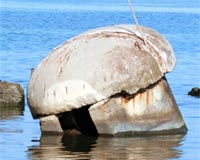| . |  |
. |
Ann Arbor MI (SPX) May 06, 2010 Among the worrisome environmental effects of global warming is the thawing of Arctic permafrost---soil that normally remains at or below the freezing point for at least a two-year period and often much longer. Monitoring changes in permafrost is difficult with current methods, but a study by University of Michigan researchers offers a new approach to assessing the extent of the problem. The new study approach, which relies on chemical tracers in stream water, is described in the journal Chemical Geology. Overlying permafrost is a thin "active layer" that thaws every summer, and increases in the thickness of this layer over the years indicate thawing of permafrost. Both physical measurements and modeling suggest that active layer thickness has increased in some areas over the 20th century and that if present warming trends continue, increases of up to 40 percent could occur by the end of the 21st century. Although the full effects of thawing are yet to be determined, coastal erosion and damage to the roads, buildings and pipelines that have been built on permafrost are likely outcomes. In addition, thawing permafrost may release the greenhouse gases carbon dioxide and methane into the atmosphere, triggering further warming and more permafrost thawing. Currently, the main method for determining thaw depth is with a graduated steel probe. "You stick it in the ground and see when it hits frozen material," said geochemist Joel Blum, who with ecologist George Kling and former graduate student Katy Keller undertook the new study. "We were studying the chemistry of soils in the area around Toolik Field Station in northern Alaska, and we found that once we got below the thickness that typically would thaw during summer, the soil chemistry changed dramatically," said Blum, who is the John D. MacArthur Professor of Geological Sciences. "Material that has not thawed since it was deposited by glaciers 10,000 to 20,000 years ago is now beginning to thaw, and when it does, it reacts strongly with water, which it's encountering for the first time. This soil is much more reactive than soils higher up that interact with soil water every summer." In particular, the amount of calcium, relative to sodium and barium, is higher in the newly-thawed permafrost, and the ratio of the strontium isotope 87Sr to its counterpart 86Sr is lower. The researchers wondered if these chemical signatures of increasing thaw depth could be seen in local stream water. Kling, who is the Robert G. Wetzel Collegiate Professor of Ecology and Evolutionary Biology, has conducted research at Toolik Lake for many years and obtained stream water samples that had been collected over an 11-year period. When the samples were analyzed, "we saw really significant changes from year to year that were consistent with what you would predict from increasing thaw depth," Kling said. Although the method can't reveal precisely how much permafrost thawing is occurring in particular localities, it still can be a useful adjunct to current methods, Blum said. "We'd love to be able to say that we see an increase in thickness of, say, 1 centimeter over the entire watershed, but we simply can't say where in the watershed thawing is occurring. Nevertheless, we think it's important to monitor streams in Arctic regions to keep track of these kinds of changes and follow the rate of change."
Share This Article With Planet Earth
Related Links Toolik Field Station University of Michigan Water News - Science, Technology and Politics
 Water-Related Conflicts Set To Escalate
Water-Related Conflicts Set To EscalateHelsinki, Finland (SPX) May 04, 2010 Population growth, urbanisation, increasing pollution, soil erosion and climate variations are all reflected in the management and adequacy of the world's waters. The situation is particularly difficult in many developing countries, where there are growing concerns over escalating water crises and even outright water conflicts between countries and regions. "The current rate of population ... read more |
|
| The content herein, unless otherwise known to be public domain, are Copyright 1995-2010 - SpaceDaily. AFP and UPI Wire Stories are copyright Agence France-Presse and United Press International. ESA Portal Reports are copyright European Space Agency. All NASA sourced material is public domain. Additional copyrights may apply in whole or part to other bona fide parties. Advertising does not imply endorsement,agreement or approval of any opinions, statements or information provided by SpaceDaily on any Web page published or hosted by SpaceDaily. Privacy Statement |